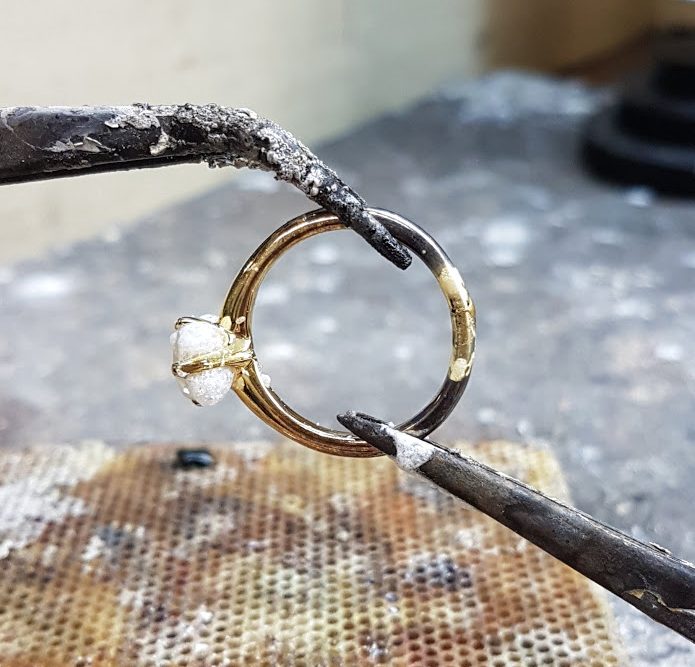Your basket is currently empty!
When doing repairs that require soldering on items that have gems in them, the jeweller needs to evaluate whether the gems will be able to withstand the heat needed to solder. Gems that cannot withstand heat may burn or discolour, and it will be safer to remove them first.
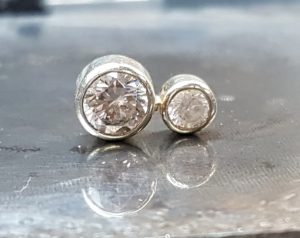
Unsetting gems are not always an option though. It is not practical to unset lots of melee-sized stones, and even unsetting fewer, larger gems are not without risk; the prongs may break, and the tops of tube settings are often destroyed in an attempt to take the gem out. There is also a risk of the gem itself getting chipped or damaged.
The trick is therefore to know when to risk it and when not to. Luckily, many gems can withstand a fair amount of heat, or can be protected from much of the heat, which makes removing them unnecessary.
There are four scenarios when a jeweller is most likely to have to solder with the gems in place: when sizing a ring, repairing a broken or worn prong, soldering the pin back onto the back of a gem-set earring, and attaching wedding bands onto a ring.
General precautions
Below are some general precautions that should be taken if you decide to solder with the gems in place:
Clean the jewellery item
Always clean the jewellery item thoroughly before heating it. Remember that you are working with an item that has been worn. Even though the item may seem fairly clean, skin cells, lotions, perfume etc will definitely have accumulated under the gems.
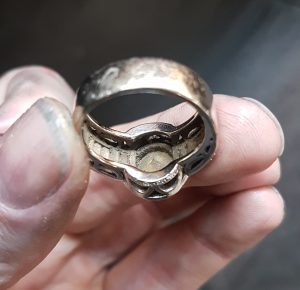
Heating a dirty ring will cause the grime to burn onto the bottoms of gems. In fact, you will smell the burning grime as it happens. Removing the blackened dirt is not that easy and it will definitely affect the appearance of the gems. Often the only way to clean it again is by repeated immersing in ammonia, repeated steam and ultrasonic cleaning, or to manually scrape it off with a tool. A magnetic tumbler can also help, providing the gem is durable enough not to get scratched by the needles in the tumbler. This is obviously not an ideal situation, and preventing it is definitely better than any of the cures…
If there are no holes underneath the settings you may have a problem, because even after leaving a ring in the ultrasonic cleaner for a day, you may not get it clean enough to prevent residual dirt burning. In fact, in the past we have had to resort to taking the gems out to be cleaned and resetting them again after this has happened…
Do not overheat
Use only the amount of heat necessary to get the job done. The less heat on the gem, the smaller the risks. One can also use solders that require less heat to flow, such as easy or extra easy solders.
Flame control is also very important. Never point the torch flame directly at a gem. Play the flame over the area to be soldered only and if you can, put the area to be soldered at the top so that the rising heat from the flame will not affect anything above it.
Protect the gem
Jewellers often use one or a combination of the precautions listed below to further protect the gems, depending on how sensitive to heat they are.
- Attach a heat sink
A heat sink is something conductive, usually metal, that is attached to the jewellery item that will lead the heat away from the gems.
The simplest way to do this is to clamp the jewellery piece with tweezers between the area to be soldered and the gem(s). In the picture below, the tweezers isolate the gem from the join where heat is going to be applied, They are also used to position the ring upside down so that the rising hot air above the flame will not affect the gem either..
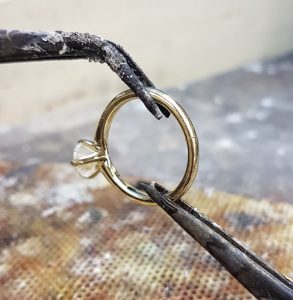
This picture shows the same ring after soldering. Notice how the ring only discoloured from oxidation up to where it is clamped by tweezers and not beyond. The gem, a diamond in this case, was covered with flux (see below) as an additional precaution.
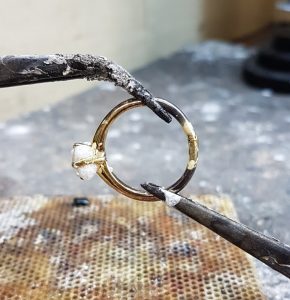
- Flux or boracic powder firecoats
A coating of flux or a boracic powder (boric acid) firecoat will create a glass-like protective barrier over gems when soldering. An additional benefit to using a firecoat is that it will protect the areas of metal around the stones from oxidation, which means that the item will require minimal clean-up after soldering in these potentially hard-to-reach places.
A word of caution though, when using a firecoat, do not overheat the coated areas. Flux and boracic powder that has burnt onto gems and metal can be very difficult to remove. Rubies and sapphires seem especially sensitive to being affected by flux and boracic powder coatings, and jewellers may opt to cover them with heat shield instead.
- Heat shield
Heat paste or heat shield is a product available from your jewellery supply store that is specifically designed to protect your gems while soldering. It is a wet putty that you heap liberally onto the gems you want to protect, from above and below. The paste will protect the stones as long as it remains moist, and you can add drops of water to keep it wet as you solder if things take longer than expected. After soldering and cooling, simply rinse the paste off under running water.
The cubic zirconias in the rings below are protected with heat shield while soldering two bands on either side of a silver engagement ring.
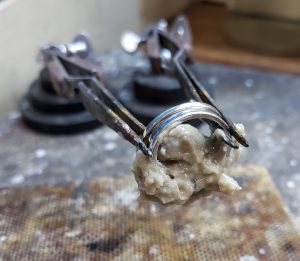
After soldering, the wet heat shield can be scraped back into its container to be used again at a later date, while the dried bits are discarded. The two pictures below show the same ring after soldering, and again after most of the heat shield has been rinsed off.
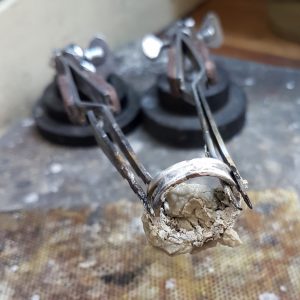
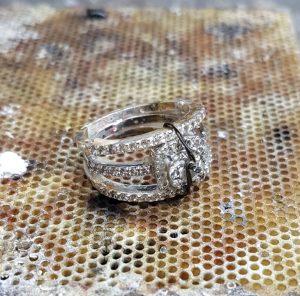
NOTE: Some metal alloys are more conductive than others and may be more difficult to solder when there is a heat sink or heat shield that leads away the heat of the flame. Silver specifically is often a challenge. The metal is so conductive that all the heat from the torch draws away from the area to be soldered, dissipating so much that the join never gets hot enough for the solder to flow, while the gems that you are trying to protect gets hotter by the minute. The best approach with silver is to take all the precautions listed here, easy solder, clamping, coating or heat shield, and then to use a hotter than usual flame concentrated on the join to get the solder to flow as quickly as possible.
Air cool
As a rule, it is better not to quench hot gems, as the sudden drop in temperature could cause it to crack or craze, though many jewellers are careless in this regard with diamonds and get away with it, most of the time. However, the safer option is to always let the jewellery item and the gems in it gradually cool off by itself to avoid thermal shock.
Soldering with specific gems
Some gems can withstand heat better than others. Diamonds are famous for their ability to withstand heat; they were after all formed in the bowels of the earth in conditions of immense pressure and high temperatures.
One can solder on top of most diamonds, to repair a prong for example, without any fear of burning it. Treated diamonds or heavily included diamonds may pose a risk, but if something happens to an untreated diamond of good to average clarity while soldering, it will be unlucky.
Below is a table with information on what we have observed from soldering close to specific gems and the precautions that we take under normal circumstances. Also know that we will veer away from the advice given below if the gem that we are working with is of exceptional quality or size, meaning that it will be hard to replace or expensive to replace if something were to happen. The key is to tap into your experience and listen to your gut in every scenario.
[ninja_tables id=”406″]
To conclude…
Unfortunately, knowing what choice to make in which scenarios comes with experience gained over time, and acquiring experience necessarily means that one will make a few mistakes along the way. The best one can do is to always communicate the risks with your customer, and to take some responsibility in sharing the cost of replacing gems when things do go wrong unexpectedly. Also remember that as the expert you are allowed to refuse to do a particularly risky repair, even if that leaves you with a very disappointed customer.
